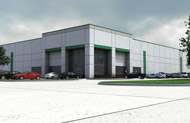| COVER STORY, JULY 2012
INDUSTRIAL ROUNDTABLE
Participants declare Texas a “bull’s-eye” for industrial activity.
Compiled by John Nelson
The industrial real estate market in Texas is outperforming most other markets in the country, according to the participants of the Texas Real Estate Business Industrial Roundtable. Doug Johnson, senior vice president and regional managing director of IDI; John Talhelm, senior vice president of Jones Lang LaSalle; and Jeff Turner, executive vice president of the South and West regions of Duke Realty, offer their insights into how the Lone Star State’s industrial market is faring today and what they anticipate in the future.
The participants were optimistic about the future and cited the state’s business-friendly atmosphere, the Port of Houston expansion, job growth, oil and gas activity and overall economic fortune as key factors contributing to the state’s healthy industrial performance thus far. Johnson, Talhelm and Turner also discussed properties that have broken ground and those that are being leased up.
Texas Real Estate Business: What is the current state of industrial activity in your market?
 |
Doug Johnson
Senior Vice President,
Regional Managing
Director
IDI
|
|
Johnson: The word ‘frenzied’ comes to mind. During the past 12 months, activity has been as strong as ever and continues to a crescendo. With major national and international companies looking for both large distribution centers (600,000-1.5 million square feet) and manufacturing locations, we have never experienced this volume of build-to-suit activity. Texas has a bull’s-eye firmly planted on it by large corporations because of its business-friendly governance as well as its status as a “right to work” state. High employment rates coupled with immigration, re-shoring and near-shoring, have buoyed the Texas economy, making it one of the best economic engines in the United States.
Talhelm: Houston’s industrial market continues to be driven by its resilient economy and international energy emphasis. As a reference, Houston began the year with more than 2.6 million payroll jobs, the highest employment level in its history. Furthermore, Houston’s unemployment rate dropped significantly, decreasing from 7.8 percent in April 2011 to 6.5 percent in April 2012. The Eagle Ford Shale formation is also bolstering Houston’s economy. As of March 2012, more than 100 rigs have been added to Eagle Ford during the past 12 months with a total count of 271 rigs. To put this into perspective, there are only 1,900-2,000 active rigs in the United States.
The Houston industrial real estate market has continued to outperform other markets of comparable size during the first quarter of 2012. Citywide vacancy rates declined 20 basis points to 4.4 percent as the market absorbed more than 1.1 million square feet of space. Once again, the Northwest submarket contributed a significant amount to overall citywide absorption, mainly a result of the high demand for crane-served freestanding buildings. Oil Field Services groups, among other energy-related and manufacturing users, have increasingly had a need for 5-10 acre tracts of land with sufficient crane capacity, hook height, and wider bays to move their equipment. As a result of the enhanced demand for such a unique product, vacancy rates for crane-served freestanding buildings are among the lowest in industrial product types.
Turner: We are fortunate that the South and West regions of the country are beginning to recover, especially on the industrial side. Two of the most improving markets are Southern California and Houston. A lot of good activity and many sales and new leases are taking place. Momentum looks pretty good across the Southwest.
TREB: What industrial leasing/development trends have surfaced during the economic downturn?
Johnson: Initial trends indicated that companies were upgrading large distribution centers to Class A space and relocating at a significant discount. Although that trend continues, we have not seen the high discounts we experienced during the heart of the downturn. As activity has picked up, we are seeing product absorbed at a premium, with rent and occupancy numbers justifying new construction of inventory buildings.
 |
John Talhelm
Senior Vice President
Jones Lang LaSalle
|
|
Talhelm: Citywide average asking rents, while growing in some of the stronger submarkets (North, Northwest and Southwest), have decreased marginally to $4.92 NNN, down one cent from the previous quarter. Despite this slight drop, rental rates are projected to remain stable or increase as the demand for quality space increases. Furthermore, new developments in North and Northwest Houston can be expected into 2012 as developers look to capitalize on improving market conditions.
A total of 40 industrial buildings were under construction at the end of the first quarter, totaling 4.16 million square feet, 1.59 million square feet of which was pre-leased.
Turner: Since 2007, there have been many contractions on the user side so, of course, bankruptcies and workouts and leasing velocity came nearly to a standstill. It has been a long and tough road to 2012 where we are finally starting to see some things tightening up. For example, occupancies are slowly getting better, there are a few build-to-suits floating around and lease rates are beginning to get better.
TREB: Have any major developments come on line this year? Are any planned?
Johnson: As most developers have quality land sites readily available from pre-recession acquisitions, no new industrial parks have been announced. However, we have seen existing “large boxes” leased. Developers are also putting current land holdings into production with some of the recently announced build-to-suits. Although a few developers are ‘kicking tires’ around various sites, the high-level of equity required for land acquisition and development will likely temper the enthusiasm for the foreseeable future.
Talhelm: Major developments under way include the 475,000-square-foot Ben E. Keith Building in Southwest Houston, the 320,000-square-foot Dyna Drill Building in the Katy market and the recently announced 300,000-square-foot Goya Foods Building in the Katy market. In addition, three speculative warehouse buildings are underway in the Northwest and North submarkets, totaling more than 680,000 square feet. The development community is being challenged by the lack of developable sites, priced for industrial development with good freeway access in the desired northwest and north submarkets.
 |
Jeff
Turner
Executive Vice
President, South and West Regions
Duke Realty
|
|
Turner: Some national developers are in the process of competing for a variety of build-to-suits across the country. It is not surprising, after years of little or no construction, that some developers are entering the spec building arena after the long lull.
TREB: What markets/submarkets are performing the best?
Johnson: Most submarkets have experienced improved performance. Specifically, the DFW submarket continues to outperform all others in the region. The Great Southwest has also experienced substantial absorption. Finally, existing, developed land sites in southern Dallas County are seeing a rise in activity from users requiring close proximity to the UPRR
intermodal and the Interstate 35/Interstate 45 and Interstate 20 infrastructure.
Talhelm: The Northwest submarket is far ahead of other markets based on overall absorption representing more than 936,000 square feet out of the total absorption of 1.08 million square feet. The north market is leading on overall rental rates due to the high buildout requirements (20 percent to 25 percent buildout) for air-freight forwarding space.
Turner: Southern California has really enjoyed a great comeback. Phoenix has made great strides the last couple of years, and Houston is clicking on all cylinders much in part to some pretty good job growth in the energy, medical and biotech fronts. Industrial fundamentals in these locations are really getting better.
TREB: What types of industrial product are performing well?
Johnson: All product types are doing well with rent and occupancy steadily increasing. Rental rates in most product types, with the exception of flex space, are back to or above the pro forma rents of 2007 and 2008.
Talhelm: The majority of new construction is centered around single-tenant, crane-served buildings. This product type ranges from 25,000 to 50,000 square feet on two- to 10-acre tracts of land. Buildings are available for sale or lease with the majority being built in the Northwest and North submarkets.
TREB: Have any major industrial users entered/exited your market?
Johnson: A large number of expansions have taken place. Many new faces have entered the market, and few, if any, have left. GE Transportation is the big newcomer, bringing close to 1,000 high-paying assembly and machining jobs to northern Fort Worth. Several other manufacturers are looking at large blocks of land in southern Dallas County, and nearly a dozen companies are looking at new distribution centers ranging from 400,000 square feet to 1.5 million square feet.
TREB: Can you describe the impact that the Panama Canal expansion and the expansion of the Port of Houston is having on the state’s industrial market?
Talhelm: The expansion of the Panama Canal was undertaken to add a new set of locks that could accommodate vessels classified as Post-Panamax Ships. These vessels are much larger than the Panamax Class vessels that currently utilize the existing locks at the canal. With respect to containerized cargo ships, Panama Class vessels are characterized by lengths under 900 feet, 110 feet beams and drafts (water depths) of 40 feet or less and cargo capacity up to 4,000 TEUs. Post-Panamax Class ships are generally 1,000 to 1,200 feet in length, have beams up to 160 feet and require draft depths of 45 feet to 52 feet and carry from 5,000 to 13,000 TEUs. Currently only three ports in the Americas can accommodate these Post Panamax Class Ships. They are Los Angeles/Long Beach, Lazaro Cardenas (West Coast of Mexico) and Norfolk, Va. Due to their location, Lazaro and Los Angeles/Long Beach are not impacted by the additional costs associated with the Panama Canal and with water depths more than 50 feet, they are accepting all Post Panamax class vessels up to 13,000 TEU capacity.
As construction on the new locks continues, port authorities around the country are trying to address their inability to serve these vessels due to a lack of water depth, aerial clearance, a lack of post Panamax class container cranes and a lack of funds to correct these inefficiencies.
Houston is faced with multiple problems for accommodating Post Panamax vessels due to the shallow dredge depths at both the Barbours Cut Terminal and the newer Bayport Container Terminal, which have no more than 40-foot water depths at their docks. In addition, the Bayport Terminal turning basin will not accommodate these larger and longer vessels without being enlarged.
 |
A rendering of the 398,000-square-foot industrial facility that Prologis is developing in Dallas. |
|
Current estimates to dredge the Bayport Channel to 45 feet have been set at $125 million. Funding for this project has not been achieved. In order for the Port of Houston to service a Post Panamax size container ship (limited to 8,000 TEU capacity), the vessel can only carry less than 50 percent of its design capacity or a maximum of 4,000 fully loaded TEU’s. Additional challenges face the port due to the fact that it is a break bulk port. Of the 220 million tons of cargo that passes through the Port of Houston, approximately 60 percent are exports, 75 percent to 80 percent of the total tonnage are petrochemicals and less than 7 percent to 7.5 percent of the total tonnage is containerized cargo. Houston also presents a challenge logistically due to its physical location. When examining supply chain tendencies, Houston is treated as a local/regional distribution location versus interstate distribution cities like Chicago, Memphis, Dallas, New York/New Jersey and Los Angeles/Long Beach.
As a result, the impact on the Houston industrial market due to the expansion of the Panama Canal will be much less than most people anticipate. Misunderstanding of the cargo makeup of the Port of Houston has resulted in high warehouse vacancies (10 percent to 12 percent) in the submarket serving the container terminals, slow absorption of space and the construction of buildings not suited for the Houston market. Currently more than 3.8 million square feet of large big box warehouse buildings sit vacant in this submarket. These buildings were constructed three or more years ago in anticipation of large retail and logistics companies moving to Houston. Unfortunately, that has not happened for many of the reasons noted above.
As Houston continues to expand in size and the oil and gas service business continues to expand, these vacancies will be absorbed and replaced by buildings more inline with Houston’s industrial demands.
Turner: It’s really too early to say although there is great speculation that it will be a difference maker in the southern area of the United States and some East Coast ports. Certainly it could serve as a good alternative to the Long Beach ports, especially in times of overcrowding or strike conditions, as we have seen before.
TREB: What is vacancy like? Are rental rates holding steady?
Johnson: By the end of the year, vacancy on quality space will be below 9 percent, which is virtually unheard of in North Texas. Rent will remain strong and continue to improve as quality existing Class A space is absorbed and there is limited new construction.
Talhelm: With the exception of the Southeast Far submarket described above, the vacancy rate in Houston continues to shrink as demand remains steady. Lease rates in the Northwest, Southwest and North submarkets are steady with slight increases. Concessions offered by landlords are no longer prevalent and will continue to be minimalized as demand increases.
Turner: Vacancies, especially on the bulk industrial side, are decreasing, and we are beginning to see pockets where there are some rental rate increases. More promising is that many concessions we have seen during the past several years are diminishing.
TREB: How is 2012 performing compared to 2011? Is there more activity/optimism?
Johnson: 2011 began slowly, but gained momentum toward the end of the year. 2012 is off the charts, and I don’t think any developer saw this coming based on 2011. Barring an unforeseeable world event or domestic terrorism, 2012-2013 could be a record-breaking period in terms of absorption of industrial space and company expansions/relocations. Both distribution space and manufacturing products will be in the millions of square feet during the next few years.
Talhelm: During the first quarter of 2012, the market was performing very well. Demand is beginning to outpace supply and the development community is beginning to respond cautiously with new land acquisitions for planned developments. The optimism is good as Eagle Ford Shale continues to develop. Overregulation by the federal government is one of the greatest concerns to stifle development.
Turner: Most real estate professionals on the industrial side will say that there is much more optimism in the air and that 2013 could be much better. Of course, a lot of outside influences can sway that, but there is pent-up demand on the sidelines as a result of such a long, tough climb.
TREB: What are your predictions for the second half of 2012 and 2013?
Talhelm: The market will remain strong through the second half of 2012 unless overregulation impacts available capital for new projects. Houston’s growth continues to be driven by the oil and gas service business as new technologies open up opportunities for energy production both domestically and internationally. Houston’s international identity will continue to draw a wide range of corporate entities to our city which will continue to fuel the commercial and industrial development.
Turner: Activity is getting better on the leasing side. Tenants are starting to think about taking more space and planning for the next cycle.
The overall market is still a bit tenuous, given the negative news from overseas. Industrial is poised to make a great comeback, and there will be several build-to-suits and spec projects started across the country by a varied list of developers. Some land sites will also get taken down in this recovery — something we haven’t seen for quite some time.
©2012 France Publications, Inc. Duplication
or reproduction of this article not permitted without authorization
from France Publications, Inc. For information on reprints
of this article contact Barbara
Sherer at (630) 553-9037.
|
